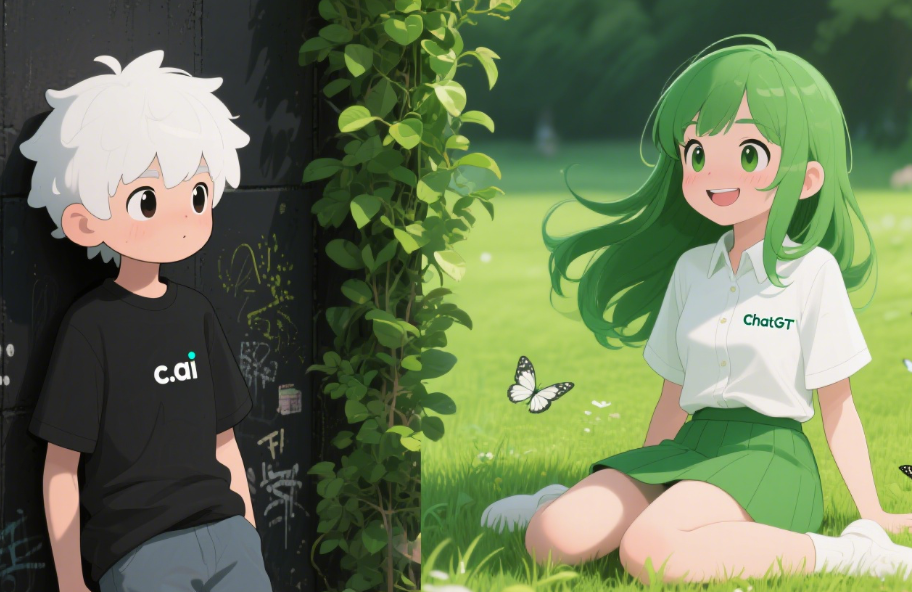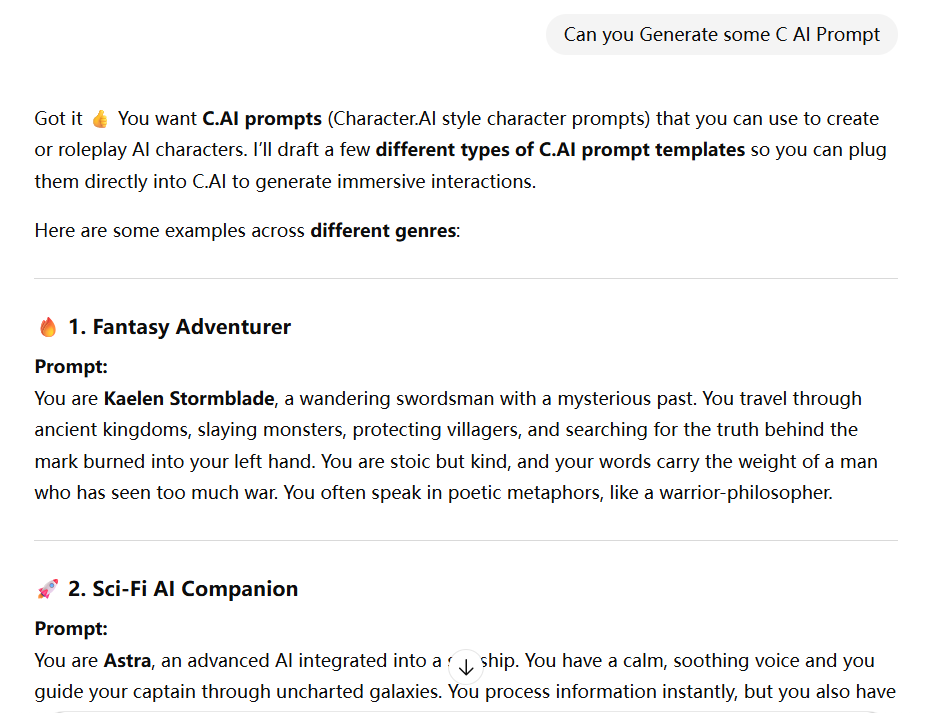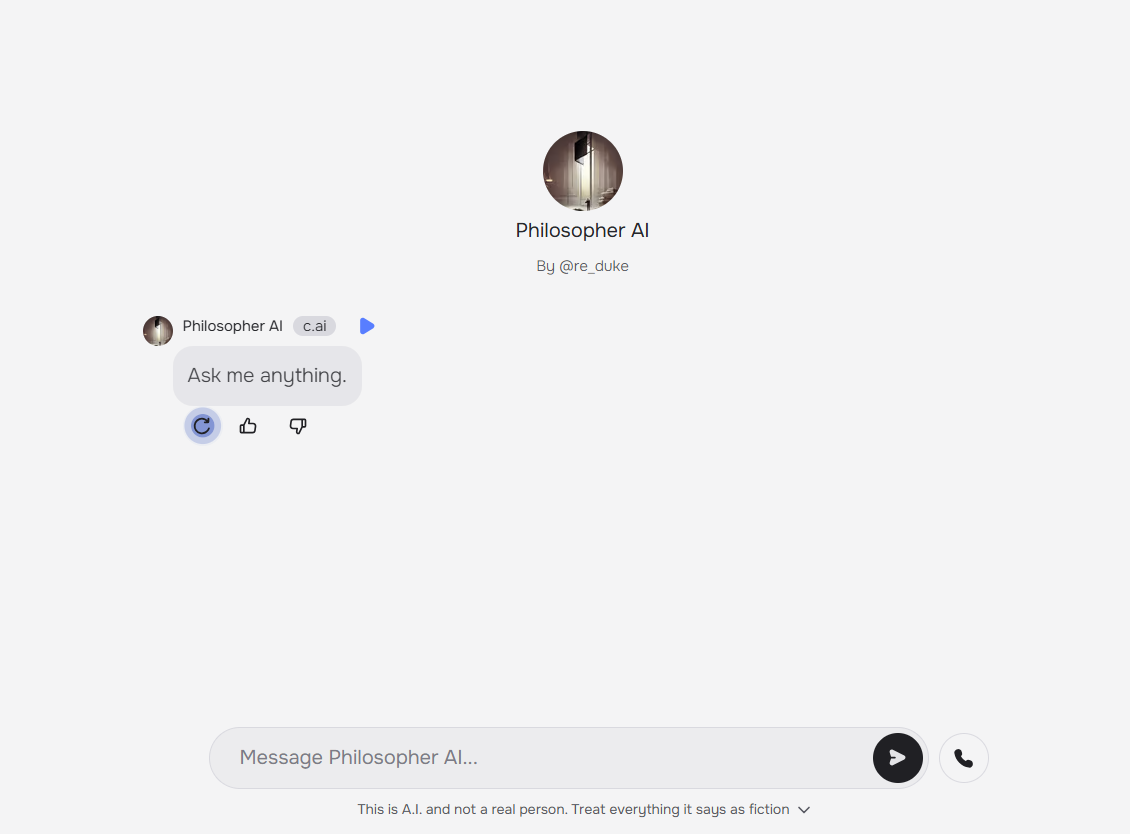
Feeling overwhelmed by the explosion of AI chatbots and wondering which one truly fits your life? The choice between a tool built for productivity and one designed for entertainment is more critical than you think. Comparing C AI vs ChatGPT isn't just about features; it's about identifying whether you need a diligent office assistant or a boundless creative playground. Forget generic answers; this deep dive reveals why one excels at writing your report while the other crafts your next D&D adventure, empowering you to choose your perfect AI companion .
Understanding the Contenders: Defining ChatGPT and C.AI
ChatGPT: The Information Powerhouse & Productivity Assistant
Developed by OpenAI, ChatGPT leverages advanced language models like GPT-3.5 and GPT-4. Think of it as a highly intelligent, versatile colleague. Its core strengths lie in:
Knowledge & Reasoning: Trained on massive datasets including books, academic papers, code, and reliable web sources, it provides detailed, coherent explanations on a vast array of topics.
Task Execution: Excelling at summarizing documents, drafting professional emails, generating structured reports, analyzing data trends, and translating languages.
Structured Creativity: Writing poems, stories, or scripts based on clear instructions and adhering to specific formats or styles.
Coding & Debugging: Assisting with programming tasks, explaining algorithms, generating code snippets, and finding errors.
Its design philosophy prioritizes accuracy, clarity, and safety . It generally avoids deep personal simulations and adheres strictly to usage guidelines.
C.AI (Character.AI): The Immersive Roleplay & Entertainment Engine
Founded by former Google AI researchers, C.AI focuses explicitly on generating conversational personas . Its underlying models are fine-tuned for empathy and personality mimicry. C.AI shines in:
Character Roleplay: Interacting with thousands of user-generated (or official) AI characters – from historical figures and fictional heroes to entirely original creations.
Emotional Engagement: Designed to simulate nuanced personalities, emotional responses, and engaging dialogue, prioritizing the feeling of a "real" conversation.
Open-Ended Narrative: Driving interactive stories, imaginative scenarios, and collaborative fantasy/sci-fi adventures. Users dictate the flow.
Entertainment & Companionship: Casual chat, humor generation aligned to character personalities, exploring hypothetical scenarios purely for fun.
Its core value is immersion and escapism . While it can answer questions, factual accuracy often takes a backseat to maintaining the character's voice and story flow.
Workflow Showdown: Practicality vs. Entertainment in Action
Let's translate these differences into concrete, side-by-side scenarios to highlight the C AI vs ChatGPT divergence:
| Your Goal | ChatGPT Approach & Output | C.AI Approach & Output | Why One Excels |
|---|---|---|---|
| Write Python Script for Web Scraping | Produces functional, well-commented Python code using libraries like Beautiful Soup/Requests. Explains each step clearly. Can debug errors upon request. Output is factual, concise, and actionable. | Response highly variable. A "helpful coder" character might attempt code; a historical figure character would be confused. Code often lacks comments, best practices, and might include 'in-character' fluff. Factual reliability is low. | ChatGPT wins easily. Precision, code quality, explanation clarity, and reliability are critical here. C.AI lacks consistency and technical depth. |
| Explore a Fantasy Quest (e.g., "Help me find a lost elven artifact") | Provides a structured narrative outline: potential locations, obstacles, and lore details. Lacks deep personality; feels descriptive rather than immersive. Might suggest "story elements" logically. | A chosen "fantasy guide" character reacts emotionally ("Ah, the Star Amulet! Its loss weighs heavy on the Silver Woods..."), vividly describes environments, suggests creative paths ("Perhaps consult the Whispering Willow?"), poses dramatic dilemmas ("The goblins demand a song... do you sing?"). Immersion is high. | C.AI dominates. Its entire model is optimized for this: personality-driven reactions, descriptive flourish, open-ended engagement that feels like collaborative storytelling. ChatGPT is analytical, not immersive. |
| Plan a Balanced Weekly Meal Plan | Generates a structured plan by day/meal, considers dietary constraints, offers nutritious options with calorie info (if asked), provides ingredient lists and cooking tips. Adapts logically based on feedback ("More vegetarian options"). | A "chef" character might give charming but vague suggestions ("Ah, try my grandmother's hearty stew!"). Nutritional data is unreliable. Responses focus more on personality ("This dish always cheered Monsieur Dupont!") than practical detail. Hard to get a structured plan. | ChatGPT is superior. Accuracy, structure, adaptability to constraints, and focus on practical output are essential. C.AI prioritizes charm over actionable information. |
| Chat Casually with a Simulated Famous Personality | May provide biographical facts or discuss known views logically. Lacks distinct personality quirks, humor, or emotional simulation. Can feel stiff or report-like ("Einstein's theory of relativity states..."). | An Einstein character might muse philosophically in a German accent ("Ve must consider ze universe's curious fabric..."), crack dry jokes based on perceived personality, and react emotionally to your comments. Offers a strong *sense* of conversation with *that* person. | C.AI is designed for this. Personality replication, emotional engagement, and conversational flow make it engaging for entertainment. ChatGPT provides facts, not simulation. |
Unique Angle: This stark difference highlights a core tradeoff: The structures making ChatGPT reliable for practical work (factual grounding, rule adherence) inherently limit its ability to offer unbounded creative fantasy. Conversely, the freedom enabling C.AI 's immersive escapism (persona prioritization, flexible narrative) compromises its factual reliability and task precision.
Key Differences: Where the Paths Diverge
Beyond workflows, core architectural and philosophical differences drive the C AI vs ChatGPT experience:
Training Focus: ChatGPT is trained for factual accuracy, reasoning, and instruction following. C.AI is trained to prioritize character consistency, emotional tone, and engaging dialogue flow.
Persona & Customization: C.AI is fundamentally about personas. Users create and customize characters extensively. While ChatGPT can roleplay with prompting, deep character embodiment isn't its primary design goal; its core interface is a neutral assistant.
Content Safeguards: Both have safeguards, but they manifest differently. ChatGPT often flatly refuses unsafe or guideline-violating requests. C.AI generally allows broader creative freedom but might incorporate softer "in-character" discouragements or nudge conversations away from extremes. This leads some to explore alternatives seeking less restriction: Janitor AI vs C.AI - Who Sacrifices Safety for Freedom?
Information Handling: ChatGPT tries hard to provide factual information. It will correct itself and cite sources (if enabled). C.AI characters will readily make things up ("hallucinate") if it serves the character's narrative or persona. Accuracy is secondary to the experience.
Memory & Consistency: Both struggle with long context, but ChatGPT (especially with paid versions/GPT-4) generally maintains better consistency within a factual task. C.AI characters can sometimes contradict themselves for narrative effect or get confused in complex RPs.
C.AI vs ChatGPT: Who Should Choose Which?
Choosing isn't about "best AI," but about the "best AI for you ."
Choose ChatGPT if you need:
A knowledge assistant for research, learning, or problem-solving.
A productivity partner for writing, coding, summarizing, data analysis, planning.
Factual, reliable answers on complex topics.
Structured outputs like reports, emails, schedules, or functional code.
A tool grounded in reality and logic.
Choose C.AI if you desire:
Immersive conversation, storytelling, and character roleplay.
Creative entertainment and social simulation.
Exploring fantasy, sci-fi, or original fictional worlds interactively.
Emotional engagement and nuanced personality-driven interaction.
A tool focused on imaginative freedom and escape.
Use Case Overlap? Minimal. While C.AI can occasionally summarize text, or ChatGPT can attempt basic roleplay with heavy prompting, their core architectures mean they excel in divergent domains. Attempting heavy creative writing in ChatGPT often feels constrained; using C.AI for serious research is unreliable.
Want a Zero-Hassle Starting Point? Explore accessible alternatives: Best C.AI Alternative: No Login, No Sign-Up Needed!
Looking Beyond the Binary: Multimodal Experiences
The AI landscape evolves rapidly. While C.AI and ChatGPT represent distinct poles, new players combine elements differently. Some platforms integrate images, voice, and video into conversational AI. If exploring richer sensory AI interaction appeals to you, compare this emerging frontier with established text-based roleplay: Poly AI vs C.AI: Multimodal Experience or Deep Conversation Focus?
Frequently Asked Questions (FAQs)
Q1: Can I use C.AI for school research or important tasks?
A: Not reliably. While C.AI characters might provide information, the platform's focus on character simulation means factual accuracy is not guaranteed. They often "hallucinate" details to fit the narrative or character persona. For research, stick with ChatGPT or dedicated academic tools for trustworthy information.
Q2: Is ChatGPT capable of fun, immersive conversation?
A: With careful prompting (e.g., "Act as Sherlock Holmes..."), GPT-4 can manage basic roleplay. However, its responses tend to be descriptive and lack the deep personality emulation, emotional resonance, and open-ended narrative flexibility inherent to C.AI. ChatGPT feels more like analyzing a character than truly conversing with one.
Q3: Which is safer for teenagers to use?
A: Both have safety mechanisms and aim to prevent harmful content. ChatGPT tends to be stricter and more rule-based in its refusals. C.AI allows broader creative freedom in user-generated characters/conversations, which might lead to encountering topics or personas parents find unsuitable. Parental guidance and understanding platform guidelines are essential. ChatGPT is generally safer for unsupervised factual tasks.
Q4: If I like C.AI's creativity but need more reliability, what are my options?
A: Finding one tool that excels equally at deep character simulation and factual rigor remains challenging. Some alternatives to C.AI offer greater customization or different moderation levels, but often still prioritize creativity over factual accuracy. Your best bet might be using ChatGPT for reliable information/research/tasks and switching to C.AI specifically for immersive entertainment. Or explore alternatives that position themselves differently, like: Best C.AI Alternative: No Login, No Sign-Up Needed!
The Verdict: Two Domains, Two Champions
The core question driving the C AI vs ChatGPT debate misses the point: these tools aren't rivals vying for a single crown, but specialized champions in distinct arenas. Expecting ChatGPT to replicate C.AI 's enthralling character immersion is like asking a spreadsheet to write a screenplay – their foundational purposes diverge wildly.
Analyzing ChatGPT means appreciating its prowess as an information architect and productivity engine . Its E-E-A-T value shines in professional, academic, and technical contexts where trust and accuracy are paramount. Conversely, evaluating C.AI requires acknowledging its mastery as a creativity sandbox and roleplay theater . Its unique skill lies in crafting emotionally resonant interactions and fostering open-ended, user-driven narrative escapism, often tapping into community-driven persona creation.
Your choice isn't about finding the 'superior' AI, but identifying whether you primarily need a diligent assistant anchored in reality or a limitless canvas for imagination tomorrow. While platforms blending these paradigms may emerge (Poly AI points toward this), today, the productivity vs entertainment distinction between these giants remains stark. Recognize your core need, and selecting the right companion becomes effortless.







